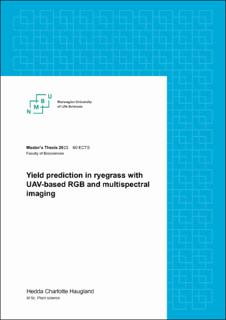| dc.description.abstract | Forage grass breeding is time-consuming and costly, with the need for special knowledge and experience to make the right decisions for future forage grass production. All measurements for decision-making require manual labor and hands-on inspections. For the yield trait, the traditional method of measurement is cutting and weighing the grass. New methods for yield prediction and measurement with Unmanned Aerial Vehicle (UAV) have been tested on different crops with good results. For perennial ryegrass (Lolium perenne L.) yield prediction has earlier been performed on plots with a flight altitude for image capturing at 20 meters and which has yielded promising results for our study.
This study has been exploring different flight altitudes for ryegrass yield prediction using UAV imagery. The sensors that have been used in this study are multispectral and RGB cameras integrated in the UAVs. Our study consists of two trials with pre-selected varieties of perennial ryegrass, one with diploid varieties and one with tetraploid varieties and mixtures between diploid and tetraploid varieties, were investigated. Both trials were seeded at two different locations in Norway. Varieties were planted as rows for the first location (Vollebekk, Ås, Norway) while for the second location (Arneberg, Ilseng, Norway) the two trials were planted as both rows and plots. The dry matter yield (DMY) data were collected with traditional harvest four times for the rows, and three times for the plots. The UAV-images were collected at different flight altitudes with both multispectral and RGB cameras. The full data processing routine was conducted on the first and second cut for both locations. Multivariate regression model was applied for DMY prediction based on UAV imagery.
The results correlated well with the predictions at Ås for both multispectral images as well as RGB methods of image acquisition. Our results indicated a high correlation between the actual DMY and the predicted DMY from both RGB images as well as multispectral images with a correlation coefficient on 0.92 for both, but at different assessment dates. The maximum correlation was acquired for the first cut from location Ås.
For location Arneberg, the acquired images could not yield results of sufficient quality, and thus, no predictions could be made. | |
